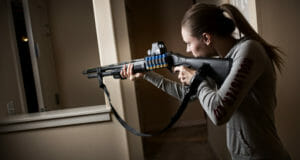The subcompact pistol is nothing new — .38 snub-nosed revolvers with 2-inch barrels have been around for over 50 years, and pistols that were relatively compact (but not subcompact) such as the Colt Officer’s model are also old timers.
There has never been, however, more varied choices in the realm of subcompact pistols than there are today, in part due to the proliferation of the concealed weapons movement. With every state now allowing concealed weapons carry in some form or another, more people are carrying, and subsequently, people are realizing that the sheer size of the pistol they happen to have in their nightstand is too big for daily carry.
Additionally, subcompacts are now offered in smaller, thinner packages than ever before, and also, can be had in some serious showstopper calibers such as .357 Magnum and .45 ACP, which was unheard of even 20 years ago. Previously, a subcompact pistol meant that it needed to be chambered in a weak caliber such as .25 auto or .380; now, it is common to find subcompacts in 9mm and .40S&W among other calibers. Why consider a subcompact in the first place? To be honest, if you are a tactical shooter such as military or law enforcement and you wear a gun exposed on your hip, you’ll most likely have little need for a subcompact, other than as a backup weapon. But if you’re a typical American, you’ll want a subcompact in part, because:
- Subcompacts are easy to conceal in a range of carry situations; from front pant pocket carry to small of the back carry, few firearms will be as easy to hide as a subcompact.
- Subcompacts weigh less, meaning you don’t develop an occupational injury by carrying a heavy gun on one side of your body.
- Lighter and smaller means you will carry the gun more often, and the gun you carry more often is the gun you are most likely to have upon your person when you need it most.
- The smaller the gun is, the easier it is to conceal, which means that it will be harder to spot by people you simply don’t want attention from.
Keep Your Handgun Locked and Loaded, Ready For Instant Use – Without Fear Of An Accident!
While subcompacts are great for carry, you want to make sure that you pick a weapon that works for your size and body type. Additionally, you want some key features in the weapon. Here’s what to look for:
- No sharp edges: Most purpose-built subcompacts are pretty good in this regard, but it bears mentioning that you want all the corners knocked off smooth, with nothing on the pistol that will snag clothing or prevent you from drawing the weapon.
- Real sights: Just because the pistol is subcompact, doesn’t mean the sights have to be. Make sure the sights are properly smoothed for easy carry, but also make sure you can properly see the sights and get a good sight picture.
- Proper grip: A subcompact usually will have a shorter or thinner grip than most pistols, sometimes it has both. If you have big hands, this might be a problem; remember, you still need to get a good master grip in order to be accurate with the weapon. Don’t buy a subcompact online; go to a gun store and actually feel the models in your hand to ensure proper fit.
- Buy a matching holster: For concealed carry, the holster is almost as important as the pistol. Don’t skimp in this regard; buy a quality holster that’s made especially for the weapon itself.
Keep in mind that you need to practice often with your carry gun, and moreso with a subcompact. Since the pistol is smaller than a normal pistol, consider that the controls will be in potentially different places than in your full size; the grip will be different, and most importantly, the pistol will have a reduced sight radius because the barrel will be correspondingly shorter. All this equates to a pistol that will be more challenging to shoot at ranges that your full-sized gun would excel in. Practice at the distances you expect to engage targets in.
Finally, and it really can’t be stated enough – you must practice drawing and firing the pistol from your concealed carry position. This means if you carry your subcompact pistol in the small of your back in a concealment holster, you need to practice drawing from this position and firing at a target. This might seem to be an unnecessary step, but trust me – if you are depending upon this pistol to potentially save your life, you want to have all the bugs worked out of the process of drawing and firing the pistol before you actually need to do it.
Subcompacts represent a great compromise from a full-sized pistol, and allow many people who would otherwise be unable to carry a pistol to be fully armed. Head to your local gun store and check one out.
 Off The Grid News Better Ideas For Off The Grid Living
Off The Grid News Better Ideas For Off The Grid Living





